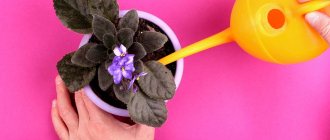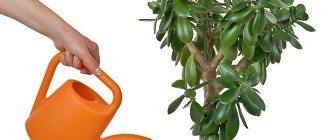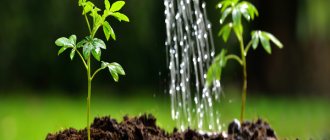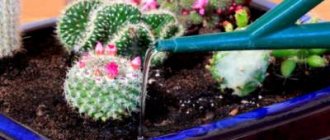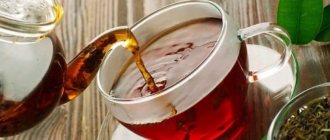What determines the frequency of irrigation?
The frequency of watering flowers depends on many factors:
Ambient temperature . In hot weather, more frequent and abundant watering is required.- Air humidity . In a room with dry air, flowers need more frequent watering and spraying.
- Type of substrate . In loose soil, evaporation occurs faster, in heavy soil it takes longer.
- Pot size . If the flower grows in a large pot, then it is necessary to reduce the amount of watering to avoid stagnation of water. If the root system occupies most of the pot, then it is better to increase the number of waterings.
- Type of pot . Plants in clay pots are watered more often than those in plastic pots.
- Location of the pot . Flowers growing on a western or northern window require moderate watering, while those on a southern window require more abundant watering.
- Flower age . A young plant requires more moisture than an adult.
- Activity state . During the period of active growth, the plant requires more moisture, while in a dormant state, minimal watering is required.
- Season . Despite the fact that house flowers are kept warm, seasonal watering must be observed. In the autumn-winter months less moisture is required, in the spring-summer months more is required.
It is better to water an adult flower with less frequency, but with an increase in watering rate.
Watering trees and shrubs
Fruit trees and shrubs should be watered rarely, but so as to thoroughly moisten the root layer of the soil. For young apple and pear trees, the layer depth is 50-70 cm, for adults – up to 80 cm; for black currants - up to 40 cm, for gooseberries - 25 cm. The general rule: after flowering, when the fruits begin to gain weight, the water consumption rate should be increased, and during the period of fruit ripening - reduced.
This is interesting: How to provide complete care for Kalanchoe Blossfeld at home
The trunk circle is a groove along the perimeter of the crown projection; it is along this groove that water should be released when watering. After watering, the ditch must be buried, and for coniferous trees, mulched. Important: do not allow water to get on the root collar of the plant; be sure to step back from the trunk.
What is attractive about water irrigation from an artesian well?
Having set the goal of extracting the maximum benefit from your own country plot with a vegetable garden during the warm season, it is important to take care of organizing an autonomous water supply system. The presence and accessibility of the desired volume of life-giving moisture will easily cope with the task without everyday hassle.
Many believe that precipitation can help - it will water the garden area with liquid, and buckets under the gutters will provide us with supplies. But, as they say, rely on the weather, and don’t make a mistake yourself. Even weather forecasters do not guarantee forecasts, so how can we be sure of the sufficiency of natural water in unforeseen circumstances? Perhaps it is better to choose a resource supply complex that suits the situation and budget than to break your back and run around with buckets and watering cans in search of water.
Of the variety of existing types of sources, the best for organizing irrigation in a remote suburban area is, undoubtedly, an artesian well. It is unnecessary to describe the advantages in a general sense. Let’s discuss only those specifically related to the vegetable garden:
- The reserve of the artesian aquifer is crystal clear, protected from external household, man-made, and other artificial pollution. Excess manganese, hardness salts, and mineralization are eliminated at the stage of equipping the source with a set of filters. The fruits collect water that the plants were watered with, so it is important to pay special attention to its quality, purity, and safety;
- High flow rate and powerful productivity will provide the area with the necessary amount of moisture. Sufficient saturation of the soil with liquid forms the correct growth of the root system, which affects the quality of fruit formation and yield;
- Independence from seasonal fluctuations in aquifers will not force you to worry about the availability of a reserve. Water does not escape during the dry season and does not overflow the structure in the off-season, since the change of seasons does not affect the deep-sea layer;
- The complex is designed for uninterrupted operation for many decades. In times of need for abundant watering, the equipment is able to function continuously without damage or shortening its service life;
- Despite the rather large amount for the initial arrangement of the structure, it pays off as quickly as possible. It is enough to compare how many times during operation it would be necessary to build an alternative source again, or the amount of payments to utility services at tariffs for supplying the resource from the central pipeline (calculating approximately a thousand cubic meters of water per hundred square meters of land).
Is it safe to water with cold water from a well?
Vegetables, fruits and berries are quite demanding regarding the temperature characteristics of irrigation water. The resource of the artesian source varies in the range of 2-6 degrees Celsius. The use of such moisture, especially in summer, will cause a shock reflex. Instead of being saturated, the roots stop allowing water to penetrate the plant, dehydration occurs, growth stops, and in some cases, the death of parts of the root system, and various types of diseases occur. An external signal of a negative reaction is the leaves that begin to fade.
Try to ensure that the temperature of the watering resource is approximately equal to the ambient degrees. Watering with cold water from a well will turn the garden into a lifeless field. Warm up the moisture in an above-ground tank, leaving it in the sun for at least a day. The following crops are considered particularly heat-loving:
- Cabbage;
- Zucchini;
- Cucumbers;
- Patissons;
- Salads;
- Melons.
How to determine moisture needs?
The fact that the flower lacks moisture is indicated by dry, lumpy soil, dried inflorescences, and drooping leaves.
You can determine the need for watering in the following ways:
- Dry soil can be easily identified with a wooden stick. If it easily penetrates the substrate and remains dry after removal, then this is a reason for watering.
- You can pick up a handful of soil; if it falls apart, then the soil is dry, it’s time to water the flower.
- Dry soil can be determined by tapping the bottom of the pot. It is given away by a ringing sound.
- Moisture indicators, lowered to the depth recommended in the instructions for use, determine soil moisture.
For your information, if the soil contains a large amount of mineral salts, the moisture indicator may be wrong.
Common mistakes
Even when acting with great love for plants, a gardener can ruin his efforts. And ignorance is to blame! So I present to your attention a few simple tips, following which will bring you much closer to enjoying the fruits of your labor.
- What kind of water should I use?
Be balanced. No need to water too hot or cold. You should also not do it under the scorching sun. Remember what happens to people on particularly hot days if they drink a lot of cold water. Plants are living, and the same thing can happen to them.
- What can't you do?
- When it so happens that you have to water under the unbearably hot sun, under no circumstances pour water on the leaves. Afterwards, tiny droplets remain on them, which become a kind of lenses, attracting sunlight to these places. Causes burns.
- How much water do you need?
- You should not douse the plant to the point of drowning. Make holes around its roots and pour water there. This method of watering is especially effective for consistently hot weather. One plant may need one glass of water, and sometimes two liters. Depends on the variety, condition and size of the plant and weather conditions.
- Additional care
- After the water dries, a crust forms in the watering areas, which does not allow air to reach the roots of the plant. She is very tough and her education definitely needs attention. Don't forget to loosen it.
- What if I'm far away?
- Sometimes you can come across the following scenario: a person who feels responsible for plantings, for example, at a dacha, arrives in the hottest sunshine, throws a hose under the plants, waters them with cold water, and then evaporates from the scene at the speed of the same moisture. Remember: you should absolutely not do this! It’s better to forget about watering, it will be more humane.
How to?
The growth of flowers and their resistance to diseases depend on the nature of watering.
In the garden, at the dacha
If the flowers are located outside, then the frequency of their watering is regulated by weather conditions and seasonality:
- in spring, flowers require moderate watering, 2-3 times a week;
- in summer, the frequency of irrigation increases; in hot weather and in the absence of precipitation, flowers are watered every other day;
- in dry autumn, plants are watered once a week.
In cool, damp weather, plants require little or no additional moisture. It is important to monitor the condition of the soil and avoid oversaturation with water.
If flowers grow on the balcony, then they need to be provided with adequate watering, just like indoor plants, but not forgetting about more frequent spraying.
Indoor
Although indoor flowers grow in constant conditions, they are also directly affected by the season. Let's look at the features of watering flowers at different times of the year:
- Spring is a time of increased development and growth. The frequency of irrigation of the land during this period depends on the air temperature, both indoors and outside, heating, and air humidity. Optimal watering varies between 3-7 days. If it is warm enough outside and the heating has not yet been turned off, then indoor plants need to be watered twice a week.
- Watering in the summer months is done at the same intervals as in the spring, 2 times a week.
- In autumn, watering home flowers is gradually reduced, taking into account the room temperature, air humidity, and soil conditions. Irrigation is usually done once a week.
- During the winter months, water indoor flowers approximately once every 7 days. Some gardeners water their flowers quite rarely in winter, once every 3-4 weeks. It is not right. Such actions can lead to drying out of the soil.
Some flowers prefer to bloom in the cold season; lack of moisture can lead to the cessation of active vegetation. Therefore, irrigation should be carried out taking into account the period of their growth and activity. Flowering plants are watered in winter at the same frequency as in summer.
Watering potatoes
How much water do potatoes need?
After planting and before sprouting, potatoes do not need to be watered.
An excess of moisture during this period does not allow the plant’s root system to develop. The first watering of potatoes is necessary approximately 3-5 days after emergence, and 2-3 liters of water should be poured under one bush.
During flowering, when tubers are set, potatoes especially need watering. One abundant watering during flowering is enough to increase potato yield by 20-30%. The rate of water consumption per bush during this period is 3-5 liters.
When and to what depth to water potatoes?
Ideally, there should be enough water to wet the soil under the potato bush to a depth of 15-20 centimeters.
In June, if the weather is hot, it is recommended to water the potatoes late in the evening.
In the second half of summer, potato beds can be watered both in the evening and early in the morning with warm water that has settled in barrels.
With the onset of September, there is no point in watering potatoes. Watering is completely stopped 5-7 days before tubers are harvested.
Schedule
It is important to pay attention to the fact that each plant has its own individual need for moisture.
Watering schedule for some flowers in the table:
| Name | Soil requirements between waterings | Watering frequency per week |
| Begonia | Without drying out the soil | 3 times |
| Ficus benjamina | Severe drying of the soil | 1 time |
| Spurge | Severe drying of the soil | 1 time |
| Spathiphyllum | Without drying out the soil | 2 times |
| Crassula | Drying out the soil between waterings | 1 time |
| Ferns | Constantly wet soil | 2-3 |
| Azalea | Easy soil drying | 2 times |
| Dracaena | Easy soil drying | 1-2 times |
| Zamioculcas | Easy soil drying | 1 time |
| Calathea | Without drying out the soil | 2 times |
Is it possible to combine watering with fertilizing?
Necessarily! Moreover, you can add replenishment during each watering. In this case, it is necessary to follow the methodology of professor and vegetable grower Mecheslav Stepuro. For every 10 liters of water you need to add:
- for the first watering: 20-30 g of potassium or calcium nitrate;
- for the second: 30-35 g of potassium monophosphate;
- for the seventh: 20-25 g of magnesium sulfate (magnesium sulfate);
- for the tenth: 0.5-1 g of water-soluble iron sulfate, manganese, zinc, copper and boric acid;
- for the thirteenth: 30 g of potassium monophosphate.
Irrigation in the heat
In the heat, flowers feel thirsty, especially if they stand on the south side under the influence of sunlight.
This moment does not always have a positive effect, especially if the air temperature reaches or exceeds 30 degrees. In this case, it is better to move them to a more shaded place.
On the street
Outdoor flowers suffer in the heat, especially if they are planted in the ground and there is no way to move them to the shade.
If the flower grows outdoors in a pot, then it is better to protect it from direct sunlight.
In hot weather, plants require daily watering . It is better to carry out these actions either early in the morning, or between 16-18 hours, in order to prevent stagnation of moisture, which has a detrimental effect on the root system.
Houses in pots
In the hot weather, indoor plants need daily humidity control and must be protected from sunlight. In hot weather, indoor flowers are watered 3 times a week, but spraying must be done every day.
If in the heat the plant is not in direct sunlight, or is not standing on a south-facing window, then watering is carried out as usual, 2 times every 7 days.
In hot weather, flowers are watered in stages: first, we irrigate the soil a little, and after the water is absorbed into the soil, we add the next portion.
What water to water the garden
The temperature and quality of irrigation water is an important factor for plants.
Why can't you water with cold water? To prevent plants from getting sick after experiencing temperature stress (the same goes for too hot water). In addition, too cold or too warm water has a bad effect on the absorption capacity of the root system and the vital activity of soil microorganisms.
Therefore, the optimal water temperature for irrigation will be neutral in the range of 15-25°C. This can be achieved by filling a large container with water from a water supply or an artesian well in the evening, letting it settle overnight (or, depending on the outside temperature, warm up during the day) and reach a temperature that is comfortable for the plant.
The optimal difference between water and air temperatures is 15-20°C. If it is exceeded, the fruits may crack and lose their presentation.
Even if it's hot outside and you think your plants will like cold water from a hose, it's best to take your time and let it warm up. Only cabbage, garlic and onions, which are cold-resistant crops, can be watered with cold water. But even in this case, we recommend not pouring water under the root, but spraying it using a diffuser.
Sedimentation of water (especially tap water, river water) will also help to precipitate or evaporate possible harmful impurities, such as chlorine, in the first case, or an abundance of suspended particles, in the second. Ordinary water for irrigation can be alternated twice with healing infusions. For example, 3 tbsp. ash per 3 liters of water or the peel of two large onions, infused for a couple of days in 3 liters of water.
You can also use rainwater for irrigation, but only if there are no industrial facilities near your site. Otherwise the water will be contaminated.
What to do if the plant is flooded?
Both excess and lack of moisture have equally detrimental effects on flowers. Step-by-step actions when flooding a plant:
- As soon as possible, carefully remove the flower with the earthen lump from the pot;
- carefully examine the root system for rot;
- if there are rotten roots, remove them;
- wrap the earthen lump in paper, leave for some time until completely dry, the amount of time depends on the degree of flooding;
- if the plant is heavily overwatered, then carefully soak the root system with a cloth;
- replace the pot or rinse the same one thoroughly and dry it;
- fill in new drainage and substrate;
- replant the flower and avoid overflowing.
Note: after overwatering, the leaves will become limp, turn brown, fall off and rot, and mold may appear on the surface of the soil.
The video will tell you what to do if the plant is flooded:
What to remember when watering plants
The roots of different vegetable crops penetrate to different depths, some reach a length of 1-1.5 m, but the most active absorption of water and minerals occurs at a depth of 20-30 cm. Therefore, each watering should provide moisture to this particular soil layer. Frequent but insignificant watering in dry weather will not bring any benefit to the plants, and sometimes will have a negative effect.
You can determine the soil moisture in the garden bed by digging a hole to a depth of 20-30 cm. If the bottom layer is dry or slightly moist, you need to urgently start watering.
You can also determine soil moisture by rolling a ball out of garden soil. Sandy soil must be watered if a ball of soil taken from the root layer (at least 15 cm deep) does not form; light loamy - if the ball disintegrates when pressed lightly; heavy - if the ball is durable.
The appearance of plants can also indicate a lack of moisture, although in hot, dry weather, even with sufficient humidity, due to intense evaporation, the root system does not have time to supply moisture, and the plant drops its leaves. In this case, the plants can be given a shower, but only in the evening.
The water requirements of vegetable plants vary. The most moisture-loving vegetables are cucumber, lettuce, spinach, cabbage, and radish. The root system of these plants is poorly developed, located in the upper layers of the soil, and the evaporating surface of the leaves is large. Thus, the mass of cucumber roots is 25 times less than the mass of leaves, and cabbage – 11 times.
Root vegetables, thanks to their deeply penetrating and widely branched roots, can extract moisture from a large volume of soil. However, they are especially demanding for proper moisture during seed germination, at the beginning of growth (when the plants have 2-4 true leaves), as well as during the formation of root crops. With an excess of moisture, stagnation of water, as well as with sharp fluctuations in soil moisture, root crops rot, crack, become deformed, develop with constrictions; with a deficiency, they turn out to be rough and woody. The optimal soil moisture is 80%, the irrigation rate is 15-20 liters per 1m2 when wetting it to a depth of 30 cm.
Onions require little water for their harvest, but due to the compactness of the root system, they really need water in the first three weeks after sowing, during the period of massive feather growth and bulb formation. During watering, a 20-30 cm layer of soil should be well moistened. Late watering delays the ripening of the bulb and impairs its keeping quality. Therefore, 2 weeks before the planned harvest, stop watering the onions.
Hybrids of horses with other animals
Cucumbers and cabbage are very demanding not only in terms of soil moisture, but also air moisture. It is practically impossible to grow cucumbers without watering - their weak roots quickly die in dry soil, and large leaves evaporate a lot of moisture. With long breaks in watering, cucumbers shed flowers and ovaries, the fruits become bitter and take on an irregular, ugly shape.
What to do if you are too dry?
Watering dried flowers is done by immersion. This way you can evenly moisten the soil.
Step by step steps:
- We prepare a container with water, its temperature is from 25 to 30 degrees, more than the size of the pot.
- Place the pot with the plant there for 5-10 minutes.
- If the plant has suffered greatly from overdrying, then the pot should be kept in water until air bubbles stop being released.
- Remove the flower pot from the container.
- Let the water drain.
Note, if after watering the leaves of a wilted flower become elastic, then the plant suffered from overdrying.
The video will tell you what to do if the plant is too dry:
In the garden
When planting vegetables in open ground beds, rain will come to your aid. However, precipitation does not always replace watering. Be sure to check to what depth the soil is wet after rain. Long, calm rain is good for vegetables, but a heavy, but short downpour most often will not give a good result, it will only refresh the plants.
For some plants, in a favorable year, if precipitation occurs periodically, natural watering is sufficient. Such unpretentious crops include pumpkins, zucchini, squash, peas, and potatoes. In hot and dry weather, you will have to water them too, so as not to lose the harvest.
Other vegetables require watering to a greater or lesser extent. Its frequency depends not only on the crop’s requirements for moisture, but also on the specific conditions of your site. Light, sandy and sandy loam soils require more water and it drains away faster. Clayey, loamy, structural soils retain moisture better and can be watered less frequently. In open, sunny, windy places, as well as on soil not covered with mulch, moisture evaporates quickly.
Article on the topic
Stop the invasion. How to protect your garden and garden from pests?
Features of crops
When watering the garden, it is necessary to take into account the characteristics of individual crops.
Thus, watermelon, melon, pumpkin, corn, beetroot, and beans have the ability to extract moisture from the deep layers of the soil and belong to the category of heat-resistant plants. This group also includes most herbs.
Carrots and onions are especially demanding of watering in the first half of the growing season; later, excess moisture spoils the quality of their harvest.
Cucumbers, cabbage, radishes, lettuce, peppers, and eggplants require constant soil moisture. Potatoes require watering during the flowering period. Tomatoes know how to adapt to insufficient humidity and love watering at the root.
Within the same crop, among varieties, differences in attitude to moisture are also observed. Early ripening varieties are the most demanding, while late ripening varieties are less demanding.
Garden plants also have preferences. Strawberries are the most sensitive to watering, followed by black currants, then raspberries, gooseberries, red currants, plums, apple trees, pears and cherries. At the same time, fruit and stone fruit seedlings grown with regular watering need moisture more than those that had to initially adapt to its lack.
Watering the garden using a drip irrigation system. © gardeners



